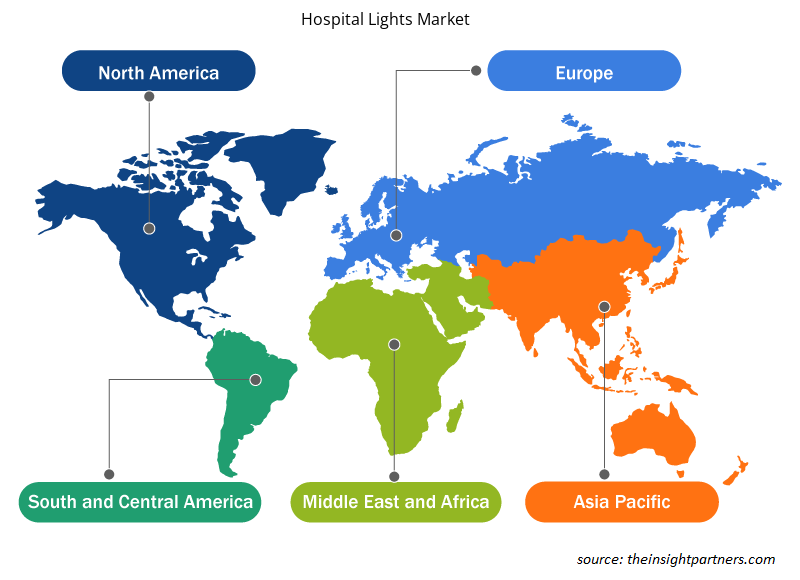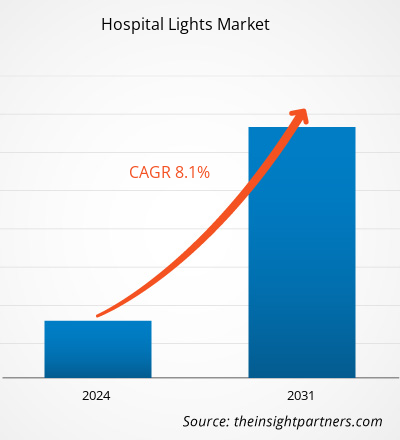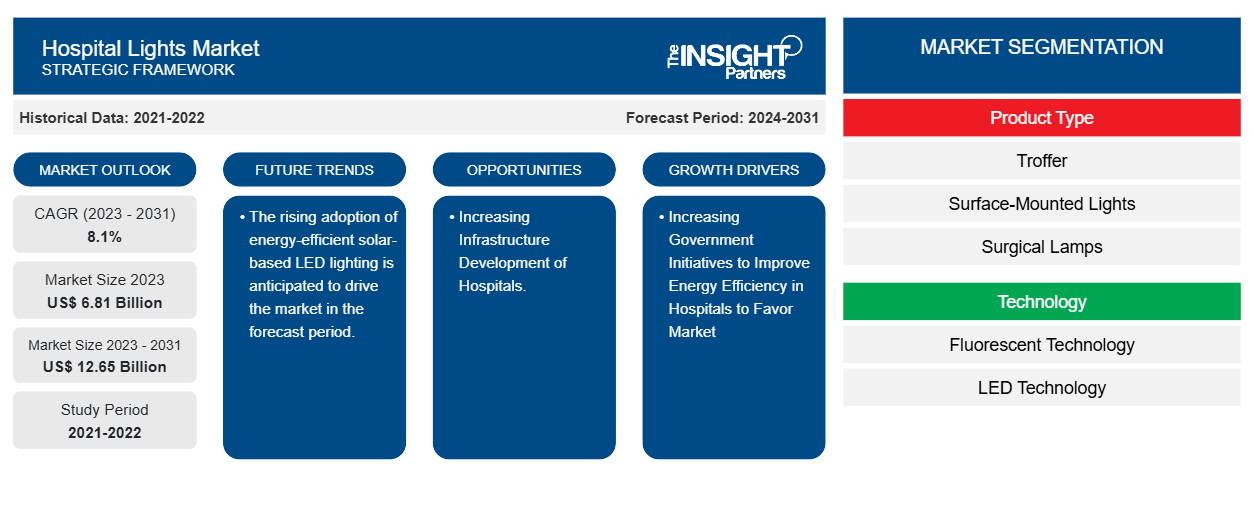Le marché des lampes d'hôpital devrait atteindre 12,65 milliards de dollars d'ici 2031, contre 6,81 milliards de dollars en 2023. Le marché devrait enregistrer un TCAC de 8,1 % au cours de la période 2023-2031. Les initiatives gouvernementales croissantes visant à améliorer l'efficacité énergétique dans les hôpitaux et la forte demande d'éclairage LED pendant les interventions chirurgicales devraient être les principales tendances et moteurs du marché des lampes d'hôpital.
Analyse du marché des lampes d'hôpital
Le marché de l'éclairage hospitalier connaît une croissance significative à l'échelle mondiale. Cette croissance est attribuée à des facteurs tels que l'augmentation des initiatives gouvernementales visant à améliorer l'efficacité énergétique dans les hôpitaux et la forte demande d'éclairage LED pendant les interventions chirurgicales. De plus, le développement croissant des infrastructures des hôpitaux et l'adoption croissante d'un éclairage LED solaire à haut rendement énergétique devraient offrir plusieurs opportunités pour le marché de l'éclairage hospitalier.
Aperçu du marché des lampes d'hôpital
L'éclairage hospitalier est défini comme l'éclairage artificiel des établissements de santé, tels que les cliniques, les hôpitaux, les maisons de retraite, etc. L'éclairage hospitalier peut être divisé en deux catégories principales : l'éclairage intérieur et l'éclairage extérieur.
Personnalisez ce rapport en fonction de vos besoins
Vous bénéficierez d'une personnalisation gratuite de n'importe quel rapport, y compris de certaines parties de ce rapport, d'une analyse au niveau des pays, d'un pack de données Excel, ainsi que d'offres et de remises exceptionnelles pour les start-ups et les universités.
- Obtenez les principales tendances clés du marché de ce rapport.Cet échantillon GRATUIT comprendra une analyse de données, allant des tendances du marché aux estimations et prévisions.
Facteurs moteurs et opportunités du marché de l'éclairage hospitalier
Accroître les initiatives gouvernementales visant à améliorer l’efficacité énergétique dans les hôpitaux afin de favoriser le marché.
L'augmentation des initiatives gouvernementales visant à améliorer l'efficacité énergétique dans les hôpitaux stimule en effet la croissance du marché à l'échelle mondiale. L'éclairage joue un rôle crucial dans les établissements médicaux. Il ne s'agit pas seulement de fournir de la lumière pour la visibilité, l'éclairage des hôpitaux a un impact sur le bien-être des patients, l'efficacité des professionnels de la santé et l'ambiance générale de l'hôpital. Pour ce bien-être, les gouvernements de divers pays et initiatives. Par exemple, en février 2022, le gouvernement indien a cherché à introduire des hôpitaux verts et numériques avec pour mission d'économiser l'énergie et de transformer le secteur de la santé. Dans le cadre de cette initiative, le gouvernement a remplacé 33 000 lampes conventionnelles par des lampes LED pour de meilleurs niveaux de lux et des économies d'énergie. Ainsi, compte tenu des facteurs ci-dessus, plusieurs initiatives gouvernementales visant à améliorer l'efficacité énergétique dans les hôpitaux stimulent le marché de l'éclairage hospitalier.
Accroître le développement des infrastructures hospitalières.
Le développement croissant des infrastructures devrait offrir plusieurs opportunités pour le marché des éclairages hospitaliers. À mesure que l'infrastructure de l'hôpital s'améliore, la demande de fournitures hospitalières et d'efficacité énergétique augmente également. En outre, de nombreux pays investissent dans le développement des infrastructures hospitalières. Par exemple, en mars 2024, le financement fédéral a alimenté des mises à niveau massives des infrastructures de santé aux États-Unis. Les projets importants à venir dans les installations médicales nécessiteront plusieurs types d'expertise industrielle ainsi qu'une abondance d'équipements, de composants de sécurité et de technologies. Ainsi, les diverses initiatives prises par le gouvernement devraient stimuler le marché des éclairages hospitaliers.
Analyse de segmentation du rapport sur le marché des lampes d'hôpital
Les segments clés qui ont contribué à l’élaboration de l’analyse du marché des éclairages hospitaliers sont le type de produit, la technologie et l’application.
- En fonction du type de produit, le marché des lampes d'hôpital est divisé en lampes encastrées, lampes montées en surface, lampes chirurgicales et autres. Le segment des lampes encastrées devrait détenir une part de marché importante au cours de la période de prévision.
- En fonction de la technologie, le marché des lampes d'hôpital est divisé en technologie fluorescente, technologie LED et autres. Le segment de la technologie fluorescente devrait détenir une part de marché importante au cours de la période de prévision.
- En fonction des applications, le marché est segmenté en services de patients et unités de soins intensifs, blocs opératoires, salles d'examen et autres. Le segment des services de patients devrait détenir une part de marché importante au cours de la période de prévision.
Analyse des parts de marché des lampes d'hôpital par zone géographique
La portée géographique du rapport sur le marché des éclairages hospitaliers est principalement divisée en cinq régions : Amérique du Nord, Asie-Pacifique, Europe, Moyen-Orient et Afrique, et Amérique du Sud et centrale.
L'Amérique du Nord domine le marché de l'éclairage hospitalier. La croissance du marché de l'éclairage hospitalier connaît une croissance en raison des initiatives gouvernementales croissantes visant à améliorer l'efficacité énergétique dans les hôpitaux et de la forte demande d'éclairage LED pendant les interventions chirurgicales dans la région. De plus, l'accent mis sur la recherche et le développement dans les économies développées des États-Unis et du Canada oblige les acteurs nord-américains à introduire sur le marché des solutions technologiquement avancées. En outre, les États-Unis comptent un grand nombre d'acteurs du marché de l'éclairage hospitalier qui se concentrent de plus en plus sur le développement de solutions innovantes. Tous ces facteurs contribuent à la croissance du marché de l'éclairage hospitalier dans la région.
Aperçu régional du marché des lampes d'hôpital
Les tendances régionales et les facteurs influençant le marché des lampes d’hôpital tout au long de la période de prévision ont été expliqués en détail par les analystes d’Insight Partners. Cette section traite également des segments et de la géographie du marché des lampes d’hôpital en Amérique du Nord, en Europe, en Asie-Pacifique, au Moyen-Orient et en Afrique, ainsi qu’en Amérique du Sud et en Amérique centrale.

- Obtenez les données régionales spécifiques au marché des lampes d'hôpital
Portée du rapport sur le marché des lampes d'hôpital
| Attribut de rapport | Détails |
|---|---|
| Taille du marché en 2023 | 6,81 milliards de dollars américains |
| Taille du marché d'ici 2031 | 12,65 milliards de dollars américains |
| Taux de croissance annuel composé mondial (2023-2031) | 8,1% |
| Données historiques | 2021-2022 |
| Période de prévision | 2024-2031 |
| Segments couverts | Par type de produit
|
| Régions et pays couverts | Amérique du Nord
|
| Leaders du marché et profils d'entreprises clés |
|
Densité des acteurs du marché : comprendre son impact sur la dynamique des entreprises
Le marché des lampes d'hôpital connaît une croissance rapide, tirée par la demande croissante des utilisateurs finaux en raison de facteurs tels que l'évolution des préférences des consommateurs, les avancées technologiques et une plus grande sensibilisation aux avantages du produit. À mesure que la demande augmente, les entreprises élargissent leurs offres, innovent pour répondre aux besoins des consommateurs et capitalisent sur les tendances émergentes, ce qui alimente davantage la croissance du marché.
La densité des acteurs du marché fait référence à la répartition des entreprises ou des sociétés opérant sur un marché ou un secteur particulier. Elle indique le nombre de concurrents (acteurs du marché) présents sur un marché donné par rapport à sa taille ou à sa valeur marchande totale.
Les principales entreprises opérant sur le marché des lampes hospitalières sont :
- Signify Holding (Philips)
- Acuity Brands, Inc.
- Éclairage Cree
- Dragerwerk AG & Co. KGaA
- Groupe KLS Martin
- Société Stryker
Avis de non-responsabilité : les sociétés répertoriées ci-dessus ne sont pas classées dans un ordre particulier.

- Obtenez un aperçu des principaux acteurs du marché des éclairages hospitaliers
Actualités et développements récents du marché des lampes d'hôpital
Le marché de l'éclairage hospitalier est évalué en collectant des données qualitatives et quantitatives après des recherches primaires et secondaires, qui comprennent d'importantes publications d'entreprise, des données d'association et des bases de données. Quelques-uns des développements du marché de l'éclairage hospitalier sont répertoriés ci-dessous :
- Royal Philips, leader mondial des technologies de la santé, a annoncé un partenariat stratégique visant à intégrer la solution avancée viQtor de smartQare aux plateformes de surveillance clinique des patients de Philips, leaders mondiaux. Cette collaboration vise à permettre la prochaine génération de surveillance continue des patients à l'intérieur et à l'extérieur de l'hôpital, en commençant par l'Europe. (Source : site Web de Royal Philips Company, avril 2024)
Rapport sur le marché des lampes d'hôpital : couverture et livrables
Le rapport « Taille et prévisions du marché des lampes hospitalières (2021-2031) » fournit une analyse détaillée du marché couvrant les domaines ci-dessous :
- Taille et prévisions du marché des lampes d'hôpital aux niveaux mondial, régional et national pour tous les segments de marché clés couverts par le périmètre
- Tendances du marché de l'éclairage hospitalier ainsi que la dynamique du marché telles que les facteurs moteurs, les contraintes et les opportunités clés
- Analyse détaillée des cinq forces de PEST/Porter et SWOT
- Analyse du marché des éclairages hospitaliers couvrant les principales tendances du marché, le cadre mondial et régional, les principaux acteurs, les réglementations et les développements récents du marché
- Analyse du paysage industriel et de la concurrence couvrant la concentration du marché, l'analyse de la carte thermique, les principaux acteurs et les développements récents sur le marché des éclairages hospitaliers
- Profils d'entreprise détaillés
- Analyse historique (2 ans), année de base, prévision (7 ans) avec TCAC
- Analyse PEST et SWOT
- Taille du marché Valeur / Volume - Mondial, Régional, Pays
- Industrie et paysage concurrentiel
- Ensemble de données Excel
Rapports récents
Rapports connexes
Témoignages
Raison d'acheter
- Prise de décision éclairée
- Compréhension de la dynamique du marché
- Analyse concurrentielle
- Connaissances clients
- Prévisions de marché
- Atténuation des risques
- Planification stratégique
- Justification des investissements
- Identification des marchés émergents
- Amélioration des stratégies marketing
- Amélioration de l'efficacité opérationnelle
- Alignement sur les tendances réglementaires





















 Obtenez un échantillon gratuit pour - Marché des lumières de l'hôpital
Obtenez un échantillon gratuit pour - Marché des lumières de l'hôpital